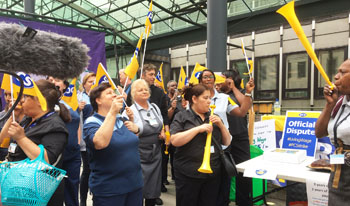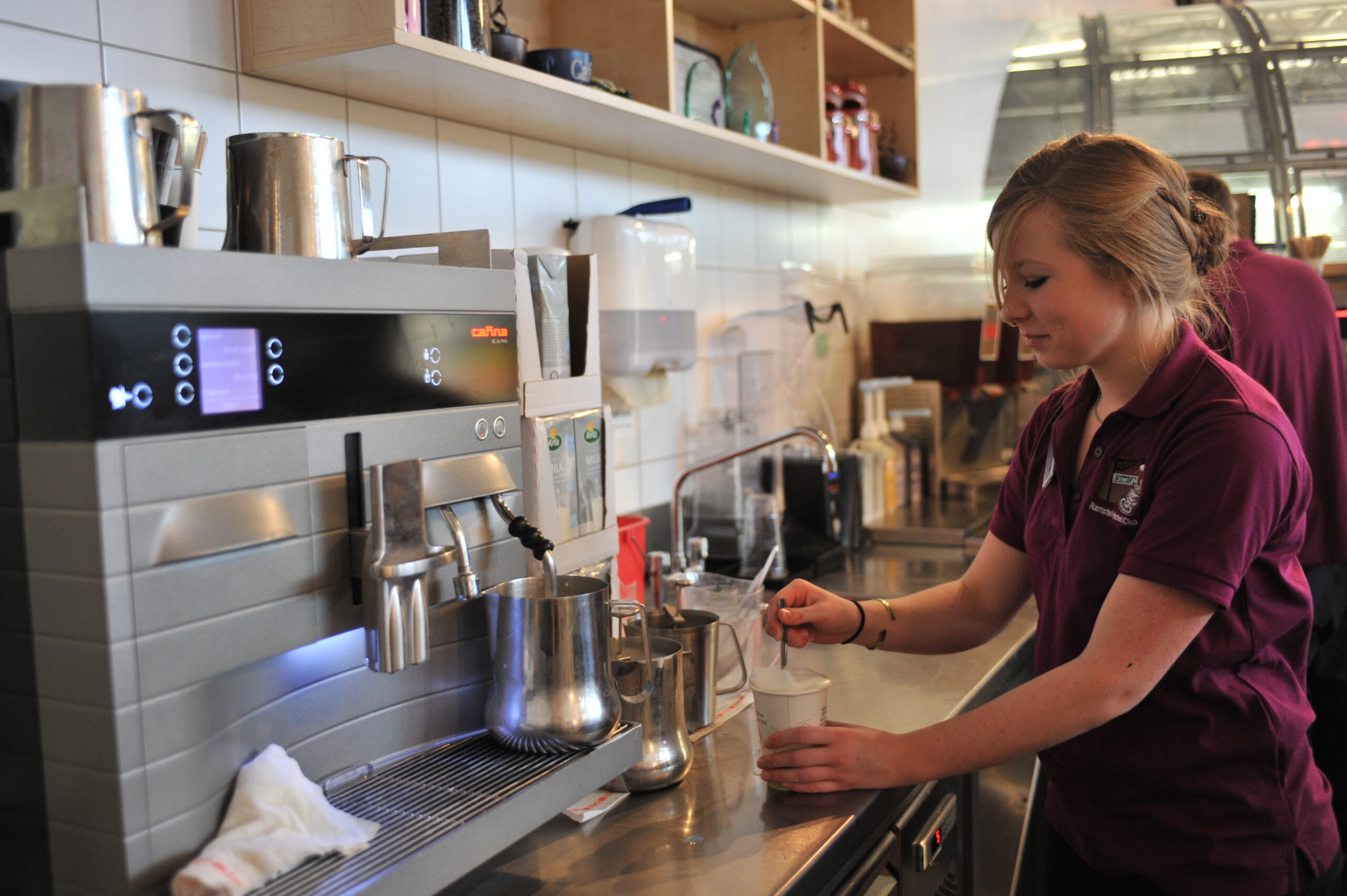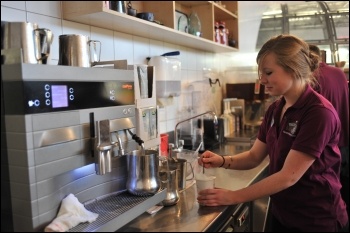Minimum wage debate: how can we end the scandal of low pay?
Alistair Tice, Socialist Party national committee
“Javin’ it large – Savid Javid vows the Tories are the ‘worker’s party’ as he hikes the minimum wage to £10.50 an hour”.
This was the Sun newspaper’s headline the day after the Conservative Chancellor’s announcement at the Tory party conference. It only mentioned in the small print that this pledge was not until 2024.
The Treasury claims that this promise will benefit four million workers by an average £4,000 a year, and “over the next five years will ….end low pay altogether.” This bold claim is made on the basis that £10.50 will, by 2024, be two thirds of median (middle) average earnings – internationally recognised as the level below which constitutes low pay.
All this is rich coming from the Tories who have implemented ten years of austerity policies that have caused the longest period of wage stagnation in Britain for 200 years. Real earnings are not expected to return to their pre-financial crash peak until 2025 – that’s 18 years!
However, this minimum wage policy is part of the Boris Johnson government’s populist agenda in preparation for a general election, along with promises of increased public spending on the NHS, schools and the police.
It may well be all a con, but the £10.50 soundbite figure gazumps Labour’s re-affirmed commitment to introduce a £10-an-hour minimum wage in 2020, a policy extended to now apply to all workers including 16-17 year olds.
Labour’s policy, if implemented, would give six million workers an average pay rise of £2,640 a year. But is £10 an hour still enough? Jeremy Corbyn first pledged it in his 2015 Labour Party leadership campaign. By next year, there will have been a 10% increase in prices since then.
The Socialist Party, which has campaigned for £10 an hour since 2013, recognised this recently by increasing our minimum wage demand to £12. Our What We Stand For column now says “Trade Union struggle for an immediate increase in the minimum wage to £12 an hour without exemptions as a step towards a real living wage of at least £15 an hour. For an annual increase in the minimum wage linked to average earnings.”
But is even £12 an hour enough to give all workers a decent living wage or should it be £15 now?
This article aims to start a discussion in the pages of the Socialist about what constitutes low pay, who decides what we need to live on, and what fighting demands the Socialist Party should raise in the labour and trade union movement to really “end low pay altogether.”
This year is the 20th anniversary of the introduction of the national minimum wage by the Tony Blair New Labour government. The Low Pay Commission, which advises the government on minimum wage levels and rises, has applauded the fact that the minimum wage has increased nearly twice as much as average earnings over the last two decades.
But this hasn’t ended low pay. In fact, in-work poverty and the number of working poor has increased. And in many sectors of the economy, such as in hotel and catering, retail and care work, the minimum wage has become the ‘going rate’, or even the maximum wage. There are now two million workers on the minimum wage compared with 770,000 when it was first introduced.
Why? There are three main reasons:
1) Real wages have fallen, and are on average still £13 a week below 2007 levels
2) Inflation – especially the rising higher costs that mostly affect working-class people such as housing, energy, public transport and child care
3) Tory cuts to in-work tax credits and benefits have far outweighed rises in the National Living Wage (NLW – the Tories’ renamed minimum wage for ‘adult’ workers) since 2016.
Even according to government figures, two million workers (7.3% of the workforce) are paid on or around the NLW. 60% are women, 60% are part-time and 90% work in the private sector.
Using the two thirds median earnings definition of low pay used by the Resolution Foundation, an ‘independent’ think tank, then 4.7 million workers (17%) are low paid.
According to The Living Wage Foundation, a campaigning organisation aiming to persuade employers to pay a Living Wage, based on an independently calculated recommended minimum wage to cover workers’ basic needs, 6.5 million workers are paid below their Real Living Wage – that’s 24% of all workers.
No wonder that in-work poverty has increased. Of the 14 million people living in relative poverty in the UK, eight million live in households where at least one person is working.
Decent standard of living
But how much pay/income is needed for a decent standard of living? The European Union, the UK government, the Resolution Foundation and, in practice, the Living Wage Foundation, all define low pay as below 60% – 70% of median earnings. However, should the workers’ movement accept government, think tank and charity definitions? Real wages have gone down or stagnated over the last 10-15 years. Which means two thirds of low pay is lower pay!
The trade unions themselves should be working out what wages/earnings are needed to guarantee every worker and working-class family a decent standard of living. The Trades Union Congress (TUC) should set up a commission involving supermarket and retail workers, housing, transport and fuel poverty campaigners, etc, along with statisticians, to formulate what’s needed.
The Minimum Income Standard (MIS) set by the social policy charity the Joseph Rowntree Foundation gives an indication of what the trade unions could do. The MIS is calculated on surveys of what the public think is needed for a decent minimum standard of living, including a smartphone, a laptop, a low budget UK holiday and Xmas presents.
Significantly, the MIS 2019 report estimates that a single person needs £18,800 a year and a working couple with two children need £51,200 between them. On the current minimum wage of £8.21 an hour, a single person is £36 a week short of the MIS and a working couple £47 a week short.
On the basis of a 35-hour week, £12 an hour would gross £21,840 a year, still leaving a working couple with children short of the MIS, whereas £15 an hour would gross £27,300 a year, taking such a family over the MIS threshold.
Fighting for the minimum wage
However, what figure the Socialist Party should call for as the minimum wage demand doesn’t just depend on what is needed to achieve a decent standard of living. It also depends on what we think we can convince the workers’ movement to campaign and struggle for, and whether workers see it as being realistic and achievable.
Most trade unions and even the TUC now support the £10 an hour minimum wage demand, at least on paper. The Bakers Union, which was one of the first to take up the campaign for £10 and initiated the Fast Food Rights campaign and McDonald’s strikes, has recently launched a call for £15, starting in London. The Socialist Party in London is raising the demand for a £15 London Living Wage.
Most workers recognise that there is a higher cost of living in London, especially housing, so would accept the need for a higher rate in the capital. But from a campaigning and mobilisation point of view, would it be better to fight for one national rate?
The current Living Wage Foundation’s London Real Living Wage is £10.55 an hour. Most London local authorities already pay it, and there have been several successful strikes to achieve it. Recently, outsourced catering workers at the Whitehall BEIS government department after three months of indefinite strike action won a victory.
£15 an hour is a 42% increase on £10.55! For workers that have had pay rises of only 1%,2%,3%, 4% or 5% tops in recent years, wouldn’t a 42% pay claim just seem like pie in the sky? The current Real Living Wage outside London is £9 an hour. To increase that to £12 an hour would be a 33% rise, to £15 a 66% rise!
It’s true that at present most workers would not regard such percentages as realistic, let alone achievable. But what is regarded as unrealistic or unachievable now can still change on the basis of a serious campaign, strategy and struggle.
The Fire Brigades Union (FBU) campaigned for a £30k salary across the board for all fire service employees back in 2002. Nearly 20 years ago. That was a 40% pay claim. It seemed OTT at the time. But the 30k figure had a galvanising effect on FBU members, generating enthusiasm and determination that this was a pay increase actually worth fighting for.
After 15 days of national strike action, the FBU won a 16% increase over two and a half years, albeit at the cost of ‘modernisation’ and future service cuts. Even so, it showed how fighting spirit can be lifted by and for a seemingly ‘unrealistic’ demand.

The moment privatised low-paid catering, cleaning, & portering workers walked out on indefinite strike action at the government department for Business, Energy and Industrial Strategy (BEIS), photo Paula Mitchell
Trade union action
The power or potential power of the trade unions is the key to whether a much higher minimum wage can be achieved. On average, pay for union members is 8% higher than for non-union workers in comparable jobs. Yet last year, 440,000 workers did not even get paid the legally required minimum wage in sectors and companies where there are no trade unions.
Today 23% of all workers are trade union members and 26% of workers are covered by union collective bargaining agreements. 90% of those on the minimum wage work in the private sector where trade union density is 13.5%.
So clearly, any serious campaign for a higher minimum wage requires a mass trade union membership, organisation and representation drive. But a bold campaign for £12 or £15 could provide just the spark, focus and energy needed to convince workers to join a trade union and take action. Especially young workers who are currently struggling on between £4.35 and £7.70 an hour and have never seen the power of unions to radically improve their lot.
Currently, only 8% of 16-25 year olds are in trade unions. But the campaigns and strikes by McDonalds workers, and at Uber, Deliveroo and TGI Fridays, have given a glimpse of their fighting potential, and must be captured for the future of the trade union movement.
Local campaigns like Sheffield Needs A Pay Rise, initiated by the local trade union council in response to Sheffield wages being £50 a week less than the national average, can play a role by targeting especially low paying employers like Sports Direct, with leverage campaigns and helping with unionisation drives.
But to deliver big pay rises in the face of the inevitable bosses’ intransigence will ultimately require widespread and coordinated industrial action. This could start at sectoral level, such as in the public sector where the 2011 pensions strike by two million workers showed the massive power trade unions still have. Or in the supermarket sector, where the Big Four, have all imposed, or are imposing, flexi-contracts – like Contract 6 at Asda.
Such sectoral action could then be coordinated into more generalised strike action. This may seem ambitious, but that is what’s needed. And the potential is there if we can transform our unions into militant, fighting organisations.
Winning such a higher minimum wage on its own would not be enough to guarantee a decent standard of living. However, the struggle involved to secure it would transform the combativity, confidence and consciousness of the working class to demand much more such as:
The indexation of the minimum wage to price rises or average earnings, whichever is the highest, as monitored by the trade unions. Plus rent caps to reduce the cost of housing, regulation of public transport to reduce fares and free child care.
Guaranteed hours and employment rights for those currently in precarious work. Ban zero hour contracts and stop bogus self-employment in the gig economy.
No youth exemptions would mean a huge increase in the minimum wage of younger workers. But this could squeeze the differentials with more experienced, skilled and semi-skilled older workers. So the unions would need to expand collective bargaining agreements, and take strike action if necessary to maintain premium payments.
Of course, employers would howl that they couldn’t afford any of this. They opposed the introduction of the minimum wage, and every increase since, claiming they threatened hundreds of thousands of job losses. That hasn’t happened yet, but a much higher minimum wage would lead to threatened closures and lock-outs.
To small businesses, a state subsidy could be offered to ensure their workers received the higher minimum wage. Currently, nearly £30 billion a year of taxpayers’ money is paid out in government tax credits to top up low pay – effectively a state subsidy to low wage employers.
But to big business, the trade unions should say “open your books, show us your accounts, where have all your profits gone?” and they should be forced to cough up. If a firm really would go bust, then it should be nationalised and brought into public ownership, which itself would point towards the need for a publicly owned and planned socialist economy that really would end low pay altogether and forever.









